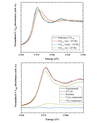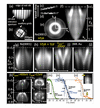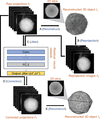issue contents
November 2021 issue

Cover illustration: Enhanced chemical state mapping techniques, coupled with multimodal X-ray spectroscopy and diffraction, reveal the spatial distribution of uranium speciation and mineralogy in simulant Chernobyl lava materials, such as the famous Elephant's foot formation; red – U; green – Zr; blue – Fe, Ni (see Ding, Dixon Wilkins, Mottram, Blackburn, Grolimund, Tappero, Nicholas, Sun, Corkhill and Hyatt, pages pages 1672–1683). The US Department of Energy is acknowledged for permission to reproduce the photograph of the Elephant's Foot formation.
facility information
actinide physics and chemistry
Open  access
access
 access
accessThis work elaborates and evaluates approaches to the construction of 2D speciation maps, in an effort to maximize sensitivity to the U oxidation state at the U L3-edge, applied to a suite of synthetic Chernobyl lava specimens.
Open  access
access
 access
accessIn situ XANES is a powerful method to collect new experimental data in the U–O phase diagram.
Open  access
access
 access
accessSynchrotron radiation based X-ray scattering techniques provide powerful bulk-sensitive probes for actinide materials. Here, selected experiments showing the potential of these techniques in advancing the knowledge of actinides and their compounds are reviewed.
The ThIV adsorption behavior of multilayered Ti3C2Tx MXene with controllable interlayer space has been investigated in detail, and the results indicate that the interlayer of MXene provides numerous adsorption sites for hydrated and intercalated samples. The adsorption mechanism has also been deciphered through spectroscopic characterization by EXAFS, X-ray diffraction and Fourier transform infrared spectroscopy.
research papers
Open  access
access
 access
accessMonolithic diamond channel-cut crystals are designed, manufactured and tested to function as high-heat-load beam-multiplexing narrow-band mechanically stable two-bounce Bragg reflection X-ray monochromators for high-power beams at cutting-edge high-repetition-rate X-ray free-electron laser (XFEL) facilities.
In this study, firstly the combination of low-energy electron microscopy (LEEM), photoemission electron microscopy (PEEM), thermionic electron microscopy (TEEM) and synchrotron radiation was applied to the surface analysis of thermionic electron materials. The LEEM, PEEM and TEEM observations have been performed in a single cathode lens microscope, and the mechanism of age-related degradation of the CeB6 cathodes which have been actually employed at SACLA X-ray free-electron laser (XFEL) facility was elucidated.
Open  access
access
 access
accessSources of error in the fixed offset between incoming and outgoing beams of a double-crystal monochromator are considered, and in order to correct such errors, a method for calibrating the monochromator crystal gap from measured variation in the X-ray beam height is provided.
Open  access
access
 access
accessA laser heating system for samples confined in diamond anvil cells paired with in situ X-ray diffraction measurements at the Extreme Conditions Beamline of PETRA III is presented.
Open  access
access
 access
accessAdaptive feedforward control of closed orbit distortion caused by fast helicity-switching undulators
A new orbit correction scheme based on the adaptive feedforward control (AFC) is presented. The developed AFC technique provides a new option in orbit control for light source stabilization at synchrotron radiation facilities.
Open  access
access
 access
accessThe applicability of synchrotron computed tomography (sCT) for the study of equine laminar structures is investigated, as well as its potential to study laminar blood flow. Based on the findings, sCT imaging has the potential to be an important addition to the `tool kit' currently used by researchers aiming to better understand the many factors that can lead to the development of equine laminitis.
Open  access
access
 access
accessAn upgraded version of the water-jet plasma X-ray source suitable for handling the 100 W power of the driving 1 kHz optical parametric chirped-pulse amplification (OPCPA) L1 Allegra laser system has been installed and commissioned at ELI Beamlines. Hard X-ray generation with the L1 Allegra laser is demonstrated for the first time.
Open  access
access
 access
accessThe positional and angular sensitivity of the far-field high-energy diffraction microscopy instrument at the 1-ID beamline of the Advanced Photon Source was characterized. The instrument is sensitive to approximately 5 µm position and 0.1° angular changes.
A new approach to facilitate advanced calculations of X-ray spectroscopies using the RSGF X-ray spectroscopy code FEFF10 and the Corvus workflow tool is presented.
Open  access
access
 access
accessA new multielement X-ray fluorescence detector is presented, specifically designed to probe the chemical speciation of trace 3d elements down to the p.p.m. range.
The thickness of a thin film formed on a substrate is easily derived using the spectral separation and log equation, which is a modified version of the formula used in the field of electron spectroscopy.
Sulfur K-edge X-ray absorption spectroscopy in combination with electronic structure calculations defines the ground state bonding in Ni2+ and Co2+ thiourea complexes. For spectral analysis the S 1s → 3p transition dipole integrals were developed and transition metal ion–thiourea bond covalencies determined.
In this article, photoactive sites such as A1 (4969 eV), A2 (4971 eV) and A3 (4972 eV) in the nano, cluster and atomic dispersed TiO2 photocatalysts can be distinguished by in situ X-ray absorption near-edge structure spectroscopy. Notably, the A2 active species in the atomic dispersed Ti (Ti-MCM-41) may be responsible for about 95% of the accumulated photocatalytic degradation of trace CHCl3 in drinking water (i.e. 7.2 p.p.m. CHCl3 gTiO2−1 h−1), which may be useful for engineering capable TiO2 photocatalysts.
A high-vacuum compatible liquid sample system for oxygen K-edge X-ray spectroscopy is presented, together with methods for mitigating oxygen contamination of X-ray sample windows.
A polymer thin-film deposition method is shown to produce high-quality substrates suitable for both static and time-resolved M-edge XANES spectroscopy.
Open  access
access
 access
accessA multimodal spectral imaging technique is demonstrated that allows simultaneous acquisition of soft X-ray transmission and X-ray excited optical luminescence. The use of a Fresnel zone plate ensures a lateral resolution of the correlative spectral images of approximately 40 nm.
Open  access
access
 access
accessThe profiles of vanadium species inside hydrated Nafion membranes have been determined using micro X-ray absorption near-edge structure spectroscopy. This proof of concept study shows how to optimize the procedure with respect to spatial resolution, statistics and species preservation.
Open  access
access
 access
accessA proof-of-principle simultaneous two-color XAS experiment on a sample containing both silver and palladium at a laboratory-scale synchrotron facility based on inverse Compton scattering is presented.
An approach is described that both abridges and partially integrates X-ray fluorescence data sets to obtain a fivefold total decrease in processing time.
Open  access
access
 access
accessThe small time gap in normal multibunch operation of storage rings is prohibitive for high-resolution time-of-flight spectroscopy but this problem can be solved by two approaches. Electron-optical pulse picking by a GHz beam blanking unit can select any desired pulse period (phase locked to the storage ring) and bandwidth pre-selection reduces the energy band entering the time-of-flight analyzer.
A deep-learning-based image jitter correction method for synchrotron nano-resolution tomographic reconstruction with superior efficiency and accuracy is presented.
Open  access
access
 access
accessA novel scheme for simultaneous X-ray ptychographic and fluorescence imaging is presented. The method is based on a dual energy X-ray beam, chromatic focusing optics and an energy discriminating photon counting detector.
short communications
The working of the hard X-ray ptychography technique at Taiwan Photon Source, with 11–20 nm spatial resolution, is demonstrated. Experimental conditions influencing the results are also discussed.
beamlines
The design, construction, performance and operation of the first infrared beamline at the Middle East synchrotron light source facility SESAME is described.
Open  access
access
 access
accessThis work is an overview of the multi-modal hard X-ray nanoprobe beamline at the MAX IV Laboratory. The beamline provides an intense and coherent beam, focused to 40–200 nm in the energy range 5–28 eV.
Open  access
access
 access
accessThe coherence properties of the beam provided at the CoSAXS beamline at the MAX IV Laboratory are determined experimentally using multi-mode ptychography. The coherent fraction of the beam is then used for a proof-of-concept XPCS measurement, illustrating the beamline's capabilities.
Open  access
access
 access
accessThe optical design and performance of the BioSAXS beamline at the Taiwan Photon Source are reported
Open  access
access
 access
accessThe paper describes the new X-ray imaging resources, including micro-computed tomography (CT), phase-contrast CT, low-temperature CT and time-resolved topography, that are available at beamline 07 of the SAGA Light Source.
Open  access
access
 access
accessThe characterization and commissioning of the X-ray photon single-shot spectrometer (PSSS) at the Aramis beamline of SwissFEL is presented. The device delivers online, non-invasive, high-resolution single-shot measurements of spectral profiles between 4 and 13 keV.
Open  access
access
 access
accessThis manuscript summarizes the capabilities of the new DIAD beamline for dual imaging and diffraction (DIAD) at Diamond Light Source, dedicated to quasi-simultaneous, time-resolved imaging/tomography and powder diffraction for 3D microstructure and phase identification/strain analysis studies.
computer programs
Open  access
access
 access
accessDaiquiri is a web-based user interface framework for control system monitoring and data acquisition.


 journal menu
journal menu
























































